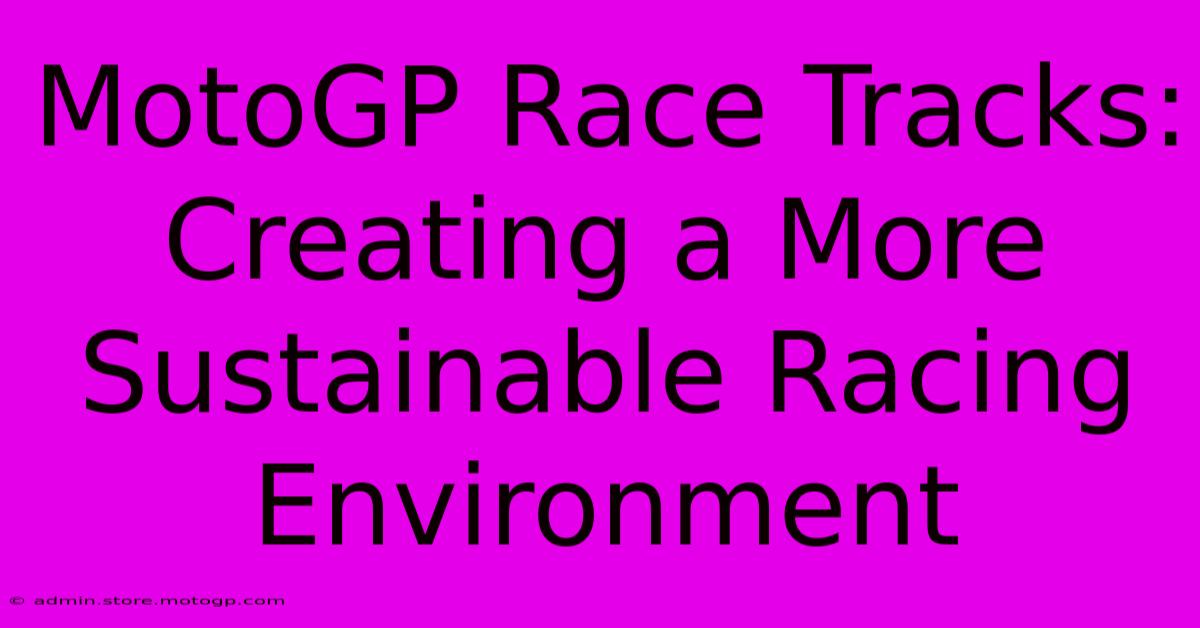MotoGP Race Tracks: Creating A More Sustainable Racing Environment

Table of Contents
MotoGP Race Tracks: Creating a More Sustainable Racing Environment
The roar of the engines, the thrill of the race, the smell of burning rubber – these are the hallmarks of MotoGP. But behind the adrenaline-fueled spectacle lies a growing awareness of the sport's environmental impact. The question isn't if MotoGP needs to become more sustainable, but how. This article explores the challenges and opportunities in creating a greener future for MotoGP race tracks and the entire racing ecosystem.
The Environmental Footprint of MotoGP
MotoGP, like any major sporting event, leaves a significant environmental footprint. This includes:
- Carbon emissions: From travel (teams, spectators, freight), energy consumption at the tracks, and the manufacturing of motorcycles themselves.
- Waste generation: Significant amounts of waste are produced, ranging from single-use plastics to discarded tires and packaging.
- Land use: Constructing and maintaining race tracks requires significant land use, often impacting local ecosystems.
- Noise pollution: The intense noise generated during races can negatively affect wildlife and nearby communities.
Sustainable Initiatives on the Track
Thankfully, MotoGP and its stakeholders are increasingly recognizing the need for change. Several initiatives are underway to reduce the sport's environmental impact:
1. Renewable Energy Sources: Powering the Future
Many circuits are exploring the transition to renewable energy sources. This includes:
- Solar power: Installing solar panels on track infrastructure to generate clean electricity.
- Wind power: Utilizing wind turbines, where geographically feasible, to supplement energy needs.
- Biofuels: Investigating the use of sustainable biofuels in support vehicles and potentially even in racing motorcycles in the future.
2. Waste Management and Recycling Programs: Minimizing Waste
Effective waste management is crucial. This involves:
- Comprehensive recycling programs: Implementing robust systems to recycle materials like plastics, metals, and tires.
- Composting: Composting organic waste to reduce landfill burden.
- Reducing single-use plastics: Encouraging the use of reusable alternatives.
- Educating fans: Raising awareness among spectators about responsible waste disposal.
3. Sustainable Construction and Materials: Building Green
Future track constructions and renovations should prioritize:
- Sustainable building materials: Using recycled and locally sourced materials whenever possible.
- Energy-efficient designs: Incorporating features that minimize energy consumption.
- Green spaces: Integrating green spaces and landscaping to enhance biodiversity and mitigate the environmental impact.
Beyond the Track: A Holistic Approach
Sustainability in MotoGP isn't just about the race tracks themselves; it requires a holistic approach encompassing:
- Sustainable transportation: Encouraging the use of public transport, cycling, and carpooling for spectators. Investing in electric vehicle charging infrastructure.
- Sustainable supply chains: Working with suppliers committed to sustainable practices throughout the motorcycle manufacturing process.
- Carbon offsetting: Investing in carbon offsetting projects to compensate for unavoidable emissions.
- Technological innovation: Researching and developing more fuel-efficient engines and sustainable materials for motorcycle construction.
The Road Ahead: Collaboration and Innovation
Creating a more sustainable MotoGP requires collaborative efforts between the Fédération Internationale de Motocyclisme (FIM), Dorna Sports, teams, manufacturers, and fans. Open communication, technological innovation, and a shared commitment to environmental responsibility are key to achieving a greener future for this thrilling sport. By embracing sustainable practices, MotoGP can continue to deliver exhilarating racing while minimizing its impact on the planet. The future of MotoGP is not just about speed and performance; it's about sustainability and responsibility. This journey will be challenging, but the rewards – a healthier planet and a more sustainable motorsport – are well worth the effort.

Thank you for visiting our website wich cover about MotoGP Race Tracks: Creating A More Sustainable Racing Environment. We hope the information provided has been useful to you. Feel free to contact us if you have any questions or need further assistance. See you next time and dont miss to bookmark.
Featured Posts
-
Austin Grand Prix Parking Lot Tickets Guaranteed Parking Guaranteed Fun
Feb 20, 2025
-
Red Bulls Grand Prix Strategy Mastering The Race
Feb 20, 2025
-
Own A Piece Of History Classic Race Bikes Available
Feb 20, 2025
-
The Science Of Speed Moto Gp On Tnt Sports
Feb 20, 2025
-
Moto2 Bike Specs A Comprehensive Guide For Beginners
Feb 20, 2025
